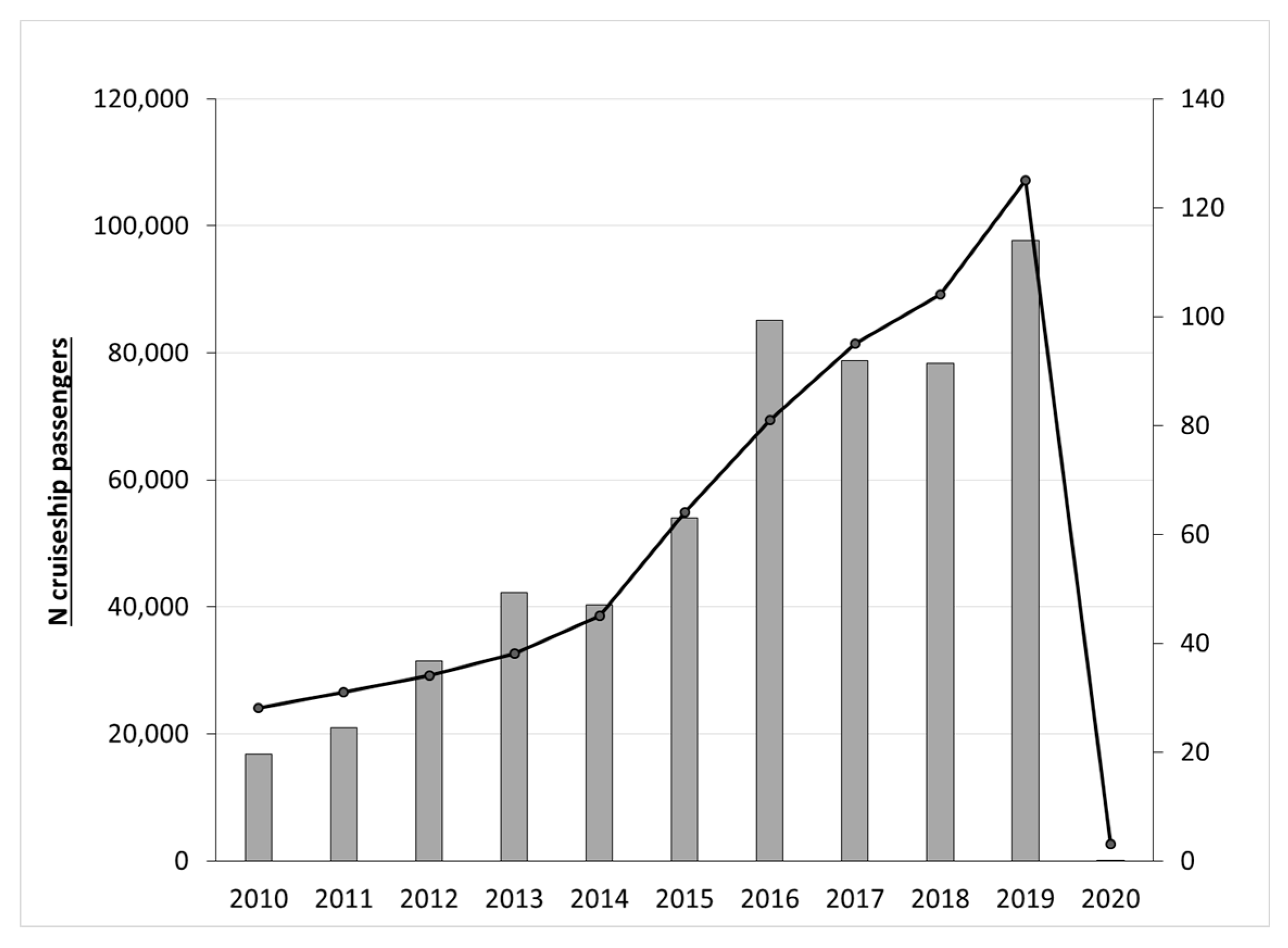Educating for the Environment: The Role of the Host Destination in Education Travel Programs
Abstract
:1. Introduction
1.1. Brief Review of Educational Travel Programs
1.2. ETP Impacts on Host Destinations
2. Methodology
2.1. Case Studies
2.1.1. ETP Context
2.1.2. Case Study 1: Chamonix-Mont Blanc Region, France
2.1.3. Case Study 2: Westfjords Region, Iceland
2.2. Data Sources
3. Findings
3.1. Destination Sustainability
3.1.1. Tourism in Chamonix-Mont Blanc
3.1.2. Tourism in the Westfjords
3.2. Partnerships for Education
3.2.1. Chamonix-Mont Blanc
3.2.2. Westfjords
3.3. Educational Opportunities
3.3.1. Chamonix-Mont Blanc
3.3.2. Westfjords
4. Discussion
5. Conclusions
Funding
Institutional Review Board Statement
Informed Consent Statement
Data Availability Statement
Acknowledgments
Conflicts of Interest
Appendix A
- How have the number of your educational programs been affected since COVID? Do you see a difference between domestic groups and international groups?
- What are the challenges you face during times of COVID, specifically with respect to field programs? (and citizen science programs—Chamonix only)
- How do you view the landscape of education programs changing during COVID?
- Do you think there might be some fundamental changes to the approach to teaching in a post-COVID world?
- How do you think the research will be impacted in the face of fewer student volunteers?
- How has COVID affected your willingness to collaborate with student groups/university groups?
- Do you think the student programs impacted the local communities economically and/or socially? Are they positive or negative? If positive, how will the crisis impact these changes?
References
- Long, J.; Vogelaar, A.; Hale, B.W. Toward sustainable educational travel. J. Sustain. Tour. 2014, 22, 421–439. [Google Scholar] [CrossRef]
- Barkin, G. Undergraduate Research on Short-Term, Faculty-Led Study Abroad. Counc. Undergrad. Res. Q. 2016, 36, 26–32. [Google Scholar] [CrossRef]
- Zhang, H.; Gibson, H.J. Long-Term Impact of Study Abroad on Sustainability-Related Attitudes and Behaviors. Sustainability 2021, 13, 1953. [Google Scholar] [CrossRef]
- Murphy, D.; Sahakyan, N.; Yong-Yi, D.; Magnan, S.S. The impact of study abroad on the global engagement of university graduates. Front. Interdiscip. J. Study Abroad 2014, 24, 1–24. [Google Scholar] [CrossRef]
- Barkin, G. Either Here or There: Short-Term Study Abroad and the Discourse of Going. Anthropol. Educ. Q. 2018, 49, 296–317. [Google Scholar] [CrossRef]
- Strange, H.; Gibson, H.J. An investigation of experiential and transformative learning in study abroad programs. Front. Interdiscip. J. Study Abroad 2017, 29, 85–100. [Google Scholar] [CrossRef]
- Landon, A.; Woosnam, K.M.; Keith, S.; Tarrant, M.; Rubin, D.; Ling, S.T. Understanding and modifying beliefs about climate change through educational travel. J. Sustain. Tour. 2019, 27, 292–307. [Google Scholar] [CrossRef]
- Luo, J.; Jamieson-Drake, D. Predictors of study abroad intent, participation, and college outcomes. Res. High. Educ. 2015, 56, 29–56. [Google Scholar] [CrossRef]
- Hatipoglu, B.; Ertuna, B.; Sasidharan, V. A referential methodology for education on sustainable tourism development. Sustainability 2014, 6, 5029–5048. [Google Scholar] [CrossRef] [Green Version]
- Paige, R.M.; Fry, G.W.; Stallman, E.M.; Josić, J.; Jon, J. Study abroad for global engagement: The long-term impact of mobility experiences. Intercult. Educ. 2009, 20, S29–S44. [Google Scholar] [CrossRef]
- Rexisen, R.J. The impact of study abroad on the development of pro-environmental attitudes. Int. J. Sustain. Educ. 2013, 9, 7–19. [Google Scholar] [CrossRef] [Green Version]
- Stoner, K.R.; Tarrant, M.A.; Perry, L.; Stoner, L.; Wearing, S.; Lyons, K. Global citizenship as a learning outcome of educational travel. J. Teach. Travel Tour. 2014, 14, 149–163. [Google Scholar] [CrossRef]
- Grabowski, S.; Wearing, S.; Lyons, K.; Tarrant, M.; Landon, A. A rite of passage? Exploring youth transformation and global citizenry in the study abroad experience. Tour. Recreat. Res. 2017, 42, 139–149. [Google Scholar] [CrossRef]
- Bell, H.L.; Gibson, H.J.; Tarrant, M.A.; Perry, L.G.; Stoner, L. Transformational learning through study abroad: US students’ reflections on learning about sustainability in the South Pacific. Leis. Stud. 2016, 35, 389–405. [Google Scholar] [CrossRef]
- McLaughlin, J.; Patel, M.; Johnson, D.K.; de la Rosa, C.L. The Impact of a Short-Term Study Abroad Program that Offers a Course-Based Undergraduate Research Experience and Conservation Activities. Front. Interdiscip. J. Study Abroad 2018, 30, 100–118. [Google Scholar] [CrossRef]
- Ling, S.; Landon, A.; Tarrant, M.; Rubin, D. Sustainability Education and Environmental Worldviews: Shifting a Paradigm. Sustainability 2020, 12, 8258. [Google Scholar] [CrossRef]
- Landon, A.C.; Tarrant, M.A.; Rubin, D.L.; Stoner, L. Beyond “Just Do It” Fostering Higher-Order Learning Outcomes in Short-Term Study Abroad. AERA Open 2017, 3, 1–7. [Google Scholar] [CrossRef] [Green Version]
- Lutterman-Aguilar, A.; Gingerich, O. Experiential pedagogy for study abroad: Educating for global citizenship. Front. Interdiscip. J. Study Abroad 2002, 8, 41–82. [Google Scholar] [CrossRef]
- Tarrant, M.A. A Conceptual Framework for Exploring the Role of Studies Abroad in Nurturing Global Citizenship. J. Stud. Int. Educ. 2009, 14, 433–451. [Google Scholar] [CrossRef] [Green Version]
- Biber, D. Transformative learning curriculum for short-term study abroad trips. J. Teach. Travel Tour. 2020, 21, 198–204. [Google Scholar] [CrossRef]
- Kilgo, C.A.; Ezell Sheets, J.K.; Pascarella, E.T. The link between high-impact practices and student learning: Some longitudinal evidence. High. Educ. 2015, 69, 509–525. [Google Scholar] [CrossRef]
- Reynolds, J.A.; Ahern-Dodson, J. Promoting Science Literacy Through Research Service-Learning—An Emerging Pedagogy With Significant Benefits for Students, Faculty, Universities, and Communities. J. Coll. Sci. Teach. 2010, 39, 24–29. [Google Scholar]
- Reynolds, J.A.; Lowman, M.D. Promoting ecoliteracy through research service-learning and citizen science. Front. Ecol. Environ. 2013, 11, 565–566. [Google Scholar] [CrossRef]
- Sauermann, H.; Vohland, K.; Antoniou, V.; Balázs, B.; Göbel, C.; Karatzas, K.; Mooney, P.; Perelló, J.; Ponti, M.; Samson, R. Citizen science and sustainability transitions. Res. Policy 2020, 49, 103978. [Google Scholar] [CrossRef]
- Dunn, R.R.; Urban, J.; Cavelier, D.; Cooper, C.B. The Tragedy of the Unexamined Cat: Why K–12 and University Education Are Still in the Dark Ages and How Citizen Science Allows for a Renaissance. J. Microbiol. Biol. Educ. 2016, 17, 4–6. [Google Scholar] [CrossRef]
- Crall, A.W.; Jordan, R.; Holfelder, K.; Newman, G.J.; Graham, J.; Waller, D.M. The impacts of an invasive species citizen science training program on participant attitudes, behavior, and science literacy. Public Underst. Sci. 2013, 22, 745–764. [Google Scholar] [CrossRef] [Green Version]
- Bela, G.; Peltola, T.; Young, J.C.; Balázs, B.; Arpin, I.; Pataki, G.; Hauck, J.; Kelemen, E.; Kopperoinen, L.; Van Herzele, A.; et al. Learning and the transformative potential of citizen science. Conserv. Biol. 2016, 30, 990–999. [Google Scholar] [CrossRef] [PubMed] [Green Version]
- Peter, M.; Diekötter, T.; Kremer, K. Participant outcomes of biodiversity citizen science projects: A systematic literature review. Sustainability 2019, 11, 2780. [Google Scholar] [CrossRef] [Green Version]
- Dvorak, A.; Christiansen, L.; Fischer, N.L.; Underhill, J.B. A Necessary Partnership: Study Abroad and Sustainability in Higher Education. Front. Interdiscip. J. Study Abroad 2011, 21, 143–166. [Google Scholar] [CrossRef]
- Wood, C.A.; Banks, S.; Galiardi, S.; Koehn, J.; Schroeder, K. Community impacts of international service-learning and study abroad: An analysis of focus groups with program leaders. Partnersh. J. Serv. Learn. Civ. Engagem. 2011, 2, 1–23. [Google Scholar]
- Schroeder, K.; Wood, C.; Galiardi, S.; Koehn, J. First, do no harm: Ideas for mitigating negative community impacts of short-term study abroad. J. Geogr. 2009, 108, 141–147. [Google Scholar] [CrossRef] [Green Version]
- Larsen, M.A.; Searle, M. Host community voices and community experiences: Tanzanian perspectives on a teacher education international service-learning project. Partnersh. J. Serv. Learn. Civ. Engagem. 2016, 7, 2. [Google Scholar]
- Ficarra, J. Producing the Global Classroom: Exploring the Impact of US Study Abroad on Host Communities in San Jose, Costa Rica and Florence, Italy. Ph.D. Thesis, Syracuse University, Syracuse, NY, USA, 2019. [Google Scholar]
- Sherraden, M.; Bopp, A.; Lough, B.J. Students serving abroad: A framework for inquiry. J. High. Educ. Outreach Engagem. 2013, 17, 7–42. [Google Scholar]
- Hale, B.W. Understanding potential impacts from university-led educational travel. Int. J. Sustain. High. Educ. 2019, 20, 245–263. [Google Scholar] [CrossRef]
- Weaver, D. Sustainable Tourism: Theory and Practice, 1st ed.; Butterworth Heinemann: Burlington, MA, USA, 2006. [Google Scholar]
- Lloyd, K.; Clark, L.; Hammersley, L.A.; Baker, M.; Rawlings-Sanaei, F.; D’ath, E. Unintended outcomes of university-community partnerships: Building organizational capacity with PACE International partners. Asia-Pac. J. Coop. Educ. 2015, 16, 163–173. [Google Scholar]
- Tompson, G.H.J.; Beekman, R.; Tompson, H.B.; Kolbe, P.T. Doing More than Learning: What Do Students Contribute during a Study Abroad Experience? J. High. Educ. Theory Pract. 2013, 13, 34. [Google Scholar]
- Gregory, L.; Schroeder, K.; Wood, C. A Paradigm Shift in International Service-Learning: The Imperative for Reciprocal Learning. Sustainability 2021, 13, 4473. [Google Scholar] [CrossRef]
- Mogford, E.; Lyons, C.J. The impacts of international service learning on a host community in Kenya: Host student perspectives related to global citizenship and relative deprivation. Front. Interdiscip. J. Study Abroad 2019, 31, 86–104. [Google Scholar] [CrossRef]
- Hale, B.W. Wisdom for traveling far: Making educational travel sustainable. Sustainability 2019, 11, 3048. [Google Scholar] [CrossRef] [Green Version]
- Larsen, M.A. International service learning: Engaging host communities—Introduction. In International Service Learning: Engaging Host Communities; Larsen, M.A., Ed.; Routledge: New York, NY, USA, 2016; pp. 3–18. ISBN 1317554582. [Google Scholar]
- Institut National de la Statistique et des Études Économiques Statisques Locales. Available online: https://statistiques-locales.insee.fr/ (accessed on 10 June 2021).
- CREA Mont-Blanc Le Massif du Mont-Blanc|ATLAS Mont-Blanc. Available online: https://www.atlasmontblanc.org/massif-mont-blanc (accessed on 28 June 2021).
- Hale, T.; Angrist, N.; Goldszmidt, R.; Kira, B.; Petherick, A.; Phillips, T.; Webster, S.; Cameron-Blake, E.; Hallas, L.; Majumdar, S.; et al. A global panel database of pandemic policies (Oxford COVID-19 Government Response Tracker). Nat. Hum. Behav. 2021, 5, 529–538. [Google Scholar] [CrossRef]
- Our World in Data COVID-19 Stringency Index. Available online: https://ourworldindata.org/grapher/covid-stringency-index (accessed on 24 June 2021).
- Eurostat GISCO: Geographical Information and Maps. Available online: https://ec.europa.eu/eurostat/web/gisco/geodata/reference-data (accessed on 30 June 2021).
- BAFU Hydrologie-Federal Office of the Environment Generalised Background Map for the Representation of Hydrological Data. Available online: https://geocat.ch (accessed on 30 June 2021).
- National Land Survey of Iceland Niðurhal. Available online: https://www.lmi.is/is/landupplysingar/gagnagrunnar/nidurhal (accessed on 13 February 2017).
- Guðjónsdóttir, S. Iceland in Figures 2018; Statistics Iceland: Reykjavík, Iceland, 2018; Volume 23. [Google Scholar]
- Visit Westfjords. The Westfjords; Westfjords Tourist Information: Isafjörður, Iceland, 2015. [Google Scholar]
- Macrotrends France Tourism Statistics 1995–2021. Available online: https://www.macrotrends.net/countries/FRA/france/tourism-statistics (accessed on 10 June 2021).
- L’Agence Savoie Mont Blanc. Les Chiffres Clés: Savoie, Haute-Savoie, Édition 2021; L’Agence Savoie Mont Blanc: Annecy, France, 2021. [Google Scholar]
- L’Agence Savoie Mont Blanc La Fréquentation des Sites Touristiques de Savoie Mont Blanc. Available online: https://pro.savoie-mont-blanc.com/Observatoire/Nos-donnees-brutes/Frequentation-des-sites (accessed on 10 June 2021).
- Óladóttir, O.Þ. Ferðaþjónusta í Tölum. Available online: https://www.ferdamalastofa.is/is/tolur-og-utgafur/ferdtjonusta-i-tolum (accessed on 10 June 2021).
- Pôle Animation Territoriale et Développement Durable. Rapport Développement Durable 2019: Des. Actions Pour Demain; Pôle Animation Territoriale et Développement Durable: Annecy, France, 2019. [Google Scholar]
- Hagstofa Íslands Gistinætur og Gestakomur á Öllum Tegundum Gististaða Eftir Sveitarfélögum 2008–2020. Available online: https://px.hagstofa.is/pxis/pxweb/is/Atvinnuvegir/Atvinnuvegir__ferdathjonusta__Gisting__3_allartegundirgististada/SAM01603.px (accessed on 11 June 2021).
- Ísafjarðarbæ Skemmtiferðaskip. Available online: https://www.isafjordur.is/is/thjonusta/samgongur/hafnir/skemmtiferdaskip (accessed on 10 June 2021).
- Sverrisdóttir, K. Untitled presentation. In Proceedings of the Ráðstefna um Skemmtiferðaskip 2017, University Center of the Westfjords, Isafjörður, Iceland, 4 April 2017; Available online: https://www.uw.is/radstefnur/glaerukynningar_2017/ (accessed on 8 June 2021).
- Ferðamálastofa (Iceland Tourist Board) Komur Skemmtiferðaskipa á Íslandi. Available online: https://www.maelabordferdathjonustunnar.is/is/farthegar/skemmtiferdaskip (accessed on 11 June 2021).
- Larkin, A.; Larsen, M.; MacDonald, K.; Smaller, H. Epistemological, methodological and theoretical challenges of carrying out ISL research involving host communities: A conversation. In International Service Learning: Engaging Host Communities; Larsen, M.A., Ed.; Routledge: New York, NY, USA, 2016; pp. 19–31. ISBN 1317554582. [Google Scholar]
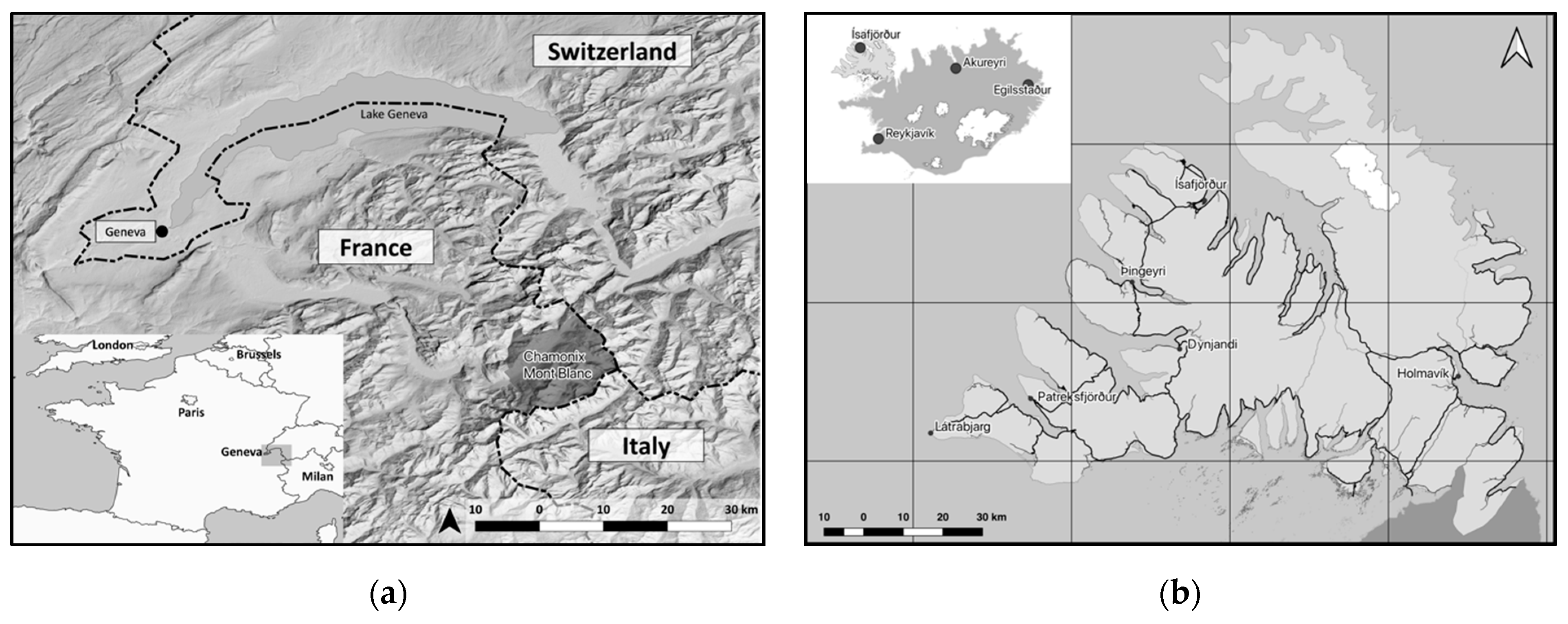
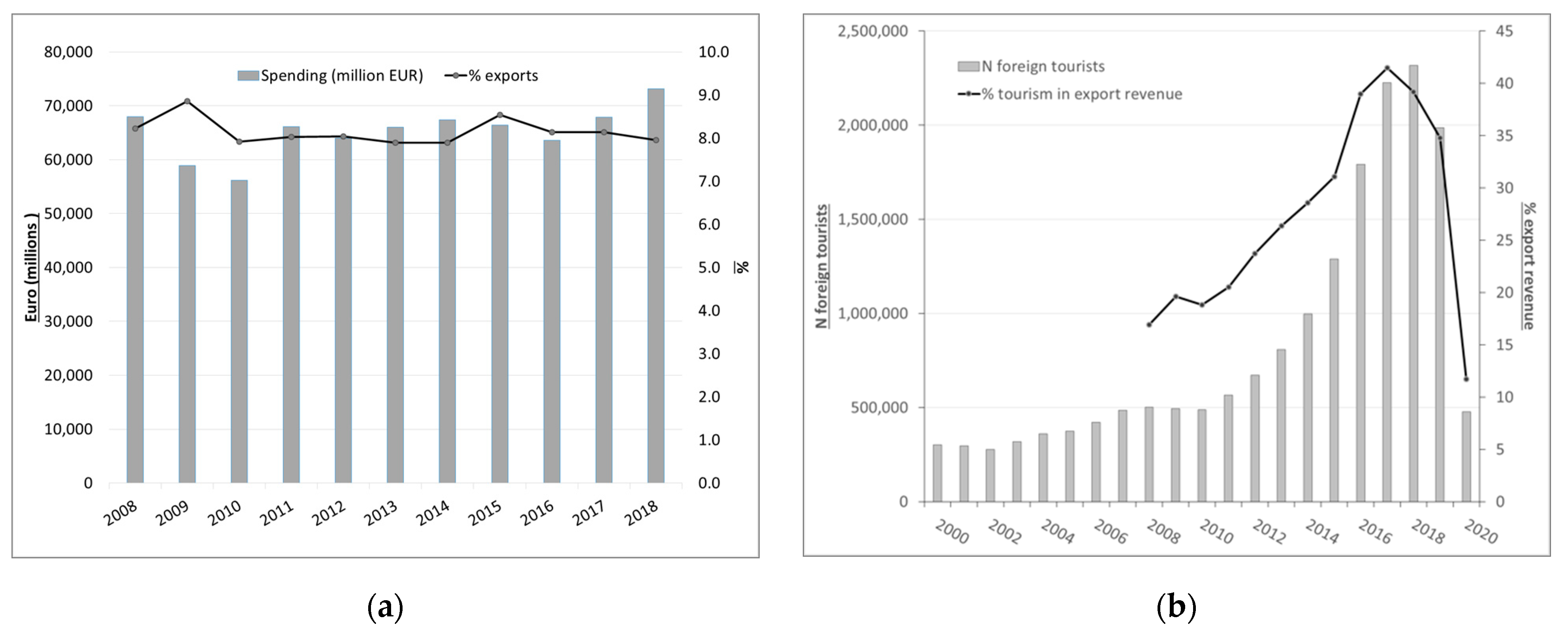
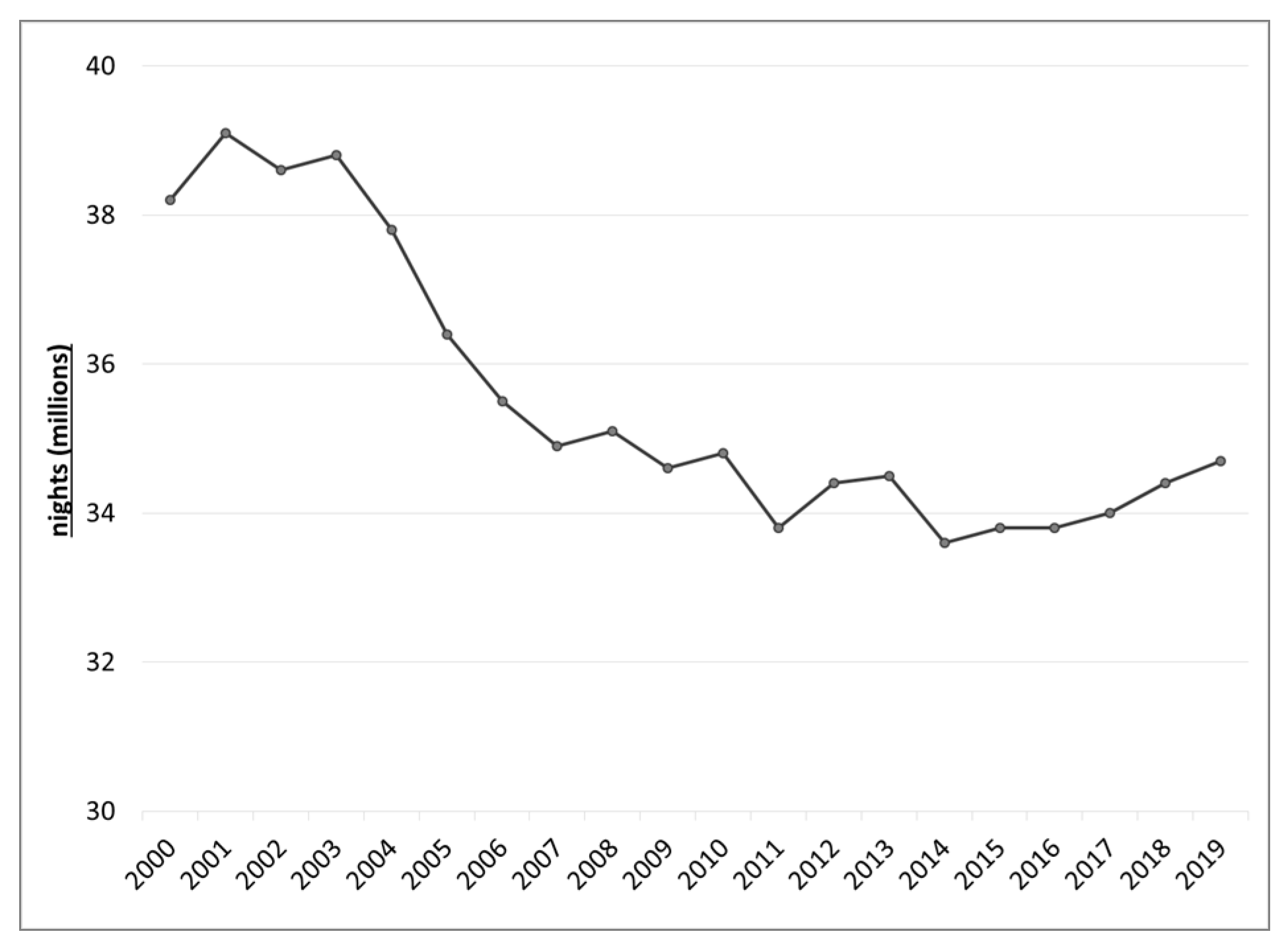

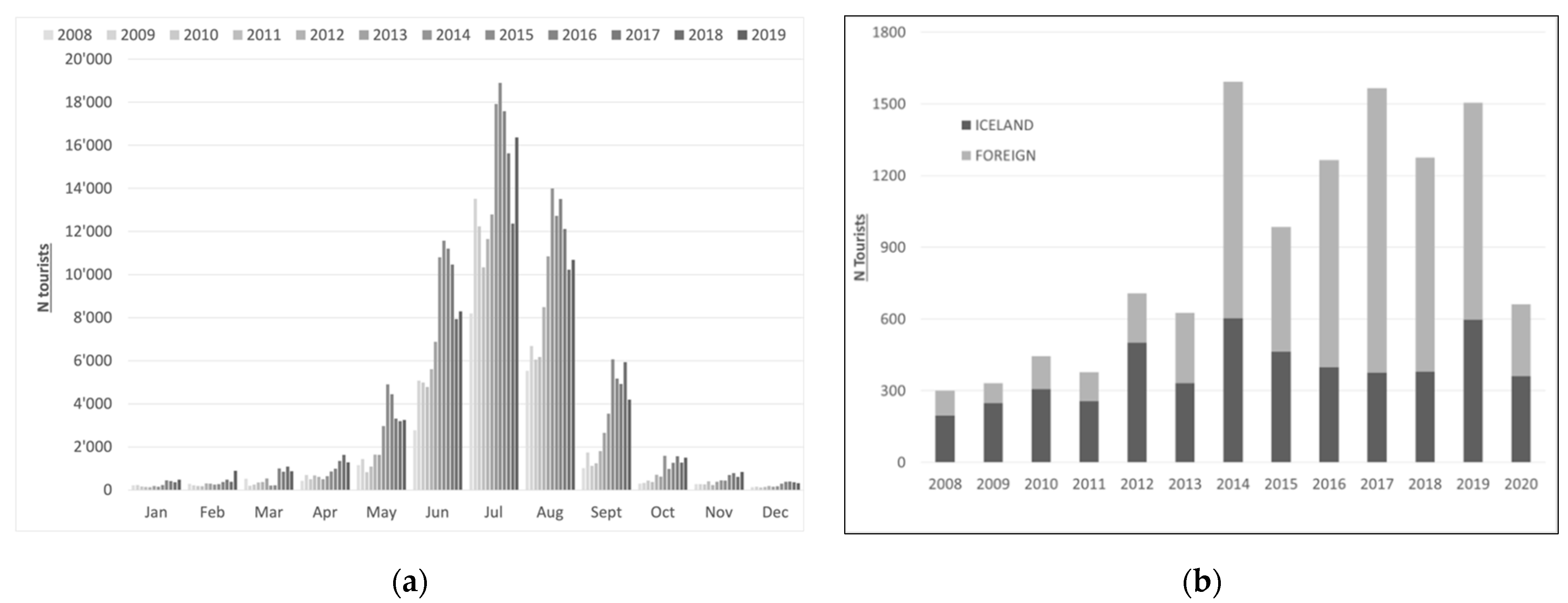
| Research Questions Related to the Program–Host Destination Relationship | Section |
|---|---|
| How does sustainability play a role in the destinations’ ETPs? | 3.1 Destination sustainability |
| What kind of local partnerships exist and how do they affect ETPs? | 3.2 Partnerships |
| How can educational activities support sustainability in ETPs in their host destinations? | 3.3 Education activities |
| How can scholars assess impacts from ETPs on their host destinations? | 4. Discussion |
Publisher’s Note: MDPI stays neutral with regard to jurisdictional claims in published maps and institutional affiliations. |
© 2021 by the author. Licensee MDPI, Basel, Switzerland. This article is an open access article distributed under the terms and conditions of the Creative Commons Attribution (CC BY) license (https://creativecommons.org/licenses/by/4.0/).
Share and Cite
Hale, B.W. Educating for the Environment: The Role of the Host Destination in Education Travel Programs. Sustainability 2021, 13, 8351. https://doi.org/10.3390/su13158351
Hale BW. Educating for the Environment: The Role of the Host Destination in Education Travel Programs. Sustainability. 2021; 13(15):8351. https://doi.org/10.3390/su13158351
Chicago/Turabian StyleHale, Brack W. 2021. "Educating for the Environment: The Role of the Host Destination in Education Travel Programs" Sustainability 13, no. 15: 8351. https://doi.org/10.3390/su13158351
APA StyleHale, B. W. (2021). Educating for the Environment: The Role of the Host Destination in Education Travel Programs. Sustainability, 13(15), 8351. https://doi.org/10.3390/su13158351





